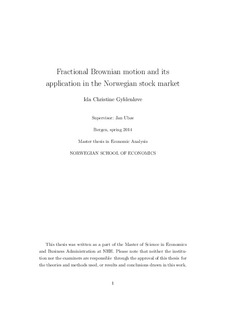| dc.description.abstract | In this thesis, I investigate the properties of fractional Brownian motion for
use in the stock market, and I also look at what types of calculus that should
be used when one works with it. I then use the calculus to see what would
happen to the market if stock returns followed fractional Brownian motion.
The second part of the thesis consists of finding a method to estimate
discretized fractional Brownian motion by using
ARFIMA
models. I apply
this theory to stocks in the Oslo Stock Exchange to look for long memory in
the returns and volatility by estimating the Hurst coeficient. Would it be
easy to make money by using this model?
I find that the fractional Brownian motion has several traits we appre-
ciate when analysing stocks. However, the market would not be eficient if
stock returns could be modelled by fractional Brownian motion, as it allows
for arbitrage.
In the Norwegian stock market, I find that the main index shows some ev-
idence of long memory in the returns. However, this is not much, as the Hurst
coeficients estimated are quite close to
1
2
. This means that it is unlikely that
one could make much money from trying to find arbitrage opportunities like
this. The same is true for the analysed stocks, and the
ARFIMA
model is
not a perfect fit for any of them.
I do find evidence of long memory in the volatility of the stock returns,
and this may be used to help understand and predict the risk of the stocks
better. | nb_NO |
